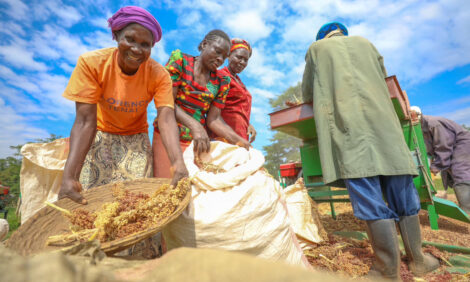



Weekly global protein digest: Sanderson, Wayne, and Cargill antitrust settlement, Consumer Price Index up
Analyst Jim Wyckoff shares an update on the US futures market, USDA reports and global protein newsAntitrust settlement requires US poultry processors to reform tournament system
Two large US poultry processors agreed to guarantee a base payment to the farmers who raise their birds, a reform of the so-called tournament system that pits growers against each other for income, said the Justice Department on Monday. The reform was part of a proposed consent decree that would order the processors, Sanderson Farms and Wayne Farms, plus Cargill Inc., to pay $84.8 million in restitution for allegedly conspiring to hold down wages paid to processing plant workers.
USDA cites food inflation
USDA raised its consumer food price forecast again, to 8.5% to 9.5% for 2022. The agency had initially predicted a 2% to 3% rise in the prices consumers pay for food this year and in February started lifting that outlook. Eggs, fats and oils, and poultry prices are making the biggest gains. In its first forecast for 2023, USDA sees inflation retracting to a 2.5%-3.5% range. The 20-year historical average for consumer food prices is a 2.4% rise.
The Consumer Price Index (CPI) for all food in 2022 at up 8.5% to 9.5% from 2021 is the highest rate of overall food price inflation since 1979, which saw prices rise 11%.
The biggest increase is for the fats and oils category, which is hiked to a 16.5%-17.5% range from a 14%-15% range. Other categories with big increases are poultry, dairy and cereals/bakery.
For food at home (grocery) prices, USDA now sees them rising 10% to 11%, the biggest rise since prices surged 10.8% in 1979.
Food away from home (restaurant) prices are expected to increase 6.5% to 7.5%, the biggest increase since the 9% hike in 1981.
This is the sixth consecutive set of monthly increases in forecasts for all food and grocery store prices, the first time that has happened based on monthly data from USDA dating back to 2003. USDA’s forecasts for restaurant prices have risen every month since January except for April and June.
For individual commodities or commodity groups, the July outlook was revised upward for 10 food categories and four aggregate categories versus forecast levels from June. Several saw no change.
Prices for eight food categories increased by at least 1%: food at home, other meats, poultry, dairy products, fats and oils, processed fruits and vegetables, sugar and sweets, cereals and bakery products, and other foods. Three of those categories were up 2%: other foods, cereals and bakery products, and fats and oils.
Annualized increases were seen in June for all food categories and in June with the smallest being for beef and veal at 4.1%. Double-digit increases were registered for all grocery store prices (12.1%) with the biggest percentage increase coming in eggs at 33.1%.
The big rise in egg prices was due to the highly pathogenic avian influenza outbreak. “This outbreak has contributed to elevated egg prices and increasing poultry prices as over 40 million birds in 37 states have been affected” USDA said.
Supply chain issues were also cited as factors for some of the food price increases. “Economy-wide factors including ongoing supply chain issues and higher energy, transportation, and labor costs, contributed to increases in prices across food categories,” USDA said.
As for 2023, this is the first outlook for food price inflation for the coming year. In 2023, food-at-home prices are forecast to rise between 2.0% and 3% with food-away-from-home prices predicted to increase between 3% and 4%. Overall food price inflation is forecast up from 2.5% to 3.5%. The 20-year average increase in food prices is 2.4% for all food prices, 2.9% for restaurant prices and 2% for grocery store prices.
Some industry contacts say USDA’s initial forecasts for 2023 appear too low.
Meanwhile, USDA’s own forecasting methodology is changing. “The Food Price Outlook forecasting methodology is being revised and will result in a revised data series,” USDA said. “A report describing the changes to the methodology is forthcoming and will be released before changes to the data series become effective.
China’s hog herd down nearly 2%
China’s hog inventory fell 1.9% from year-ago at the end of June, according to the country’s ag ministry. It noted the sow herd dropped 6.3% from year-ago. The ag ministry didn’t provide specific numbers on herd size.
Cold Storage Report: Record June beef stocks
USDA’s Cold Storage Report showed a June record 516.2 million lbs. of beef in storage. While that could imply sluggish demand, it may also be related to facilities building inventories due to ongoing strong exports. Pork stocks declined less than average during June to 541.0 million lbs., down 5.1 million lbs. from May.
Payments for US hog producers via SMHPP
USDA will issue around $62.8 million to eligible hog producers via the Spot Market Hog Pandemic Program (SMHPP) starting this week. SMHPP assists eligible producers who sold hogs through a spot market sale from April 16, 2020, through Sept. 1, 2020. While the program was originally funded at $50 million, USDA this week added $25 million to the effort. SMHPP payments are calculated by multiplying the number of head of eligible hogs, not to exceed 10,000 head, by the payment rate of $54 per head. The extra funds injected mean there will be no payment factor applied and eligible producers should receive 100% of their calculated SMHPP payment. There is no per person or legal entity payment limitation on SMHPP payments.









